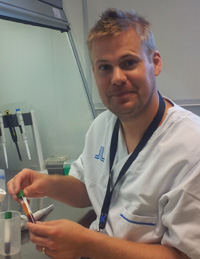Your basket is currently empty!
Invited-Editorial
Invited Editorial: The Best Strategy for Adoptive T Cell Transfer
Michael Uhlin
Division of Clinical Immunology, Karolinska University Hospital Huddinge, Stockholm, Sweden
| In the past decade, there has been substantial development in the field of immune therapy, including the use of specific T cells as treatment for various infectious agents and cancers. It was common practice in earlier days to use a laborious protocol for expansion of T cells over several weeks, including re-stimulations with either EBV-immortalized cell lines or donor-derived cells pulsed with the relevant antigens. This approach, with modifications, is still used successfully today by several groups to counteract both cancer and virus diseases.
There are, however, drawbacks associated with this methodology. If the disease progression is rapid, it will often be too late for successful infusion of cells. In addition, after implementation of more rigorous Good Manufacturing Practice (GMP) regulations (adopted also for hospital routines), the cost has increased to prohibitive levels. |
 |
Fortunately, with the new tools of today and a broader knowledge of T cell epitopes, faster and more cost-effective approaches have emerged. The invention of tetramers and Pentamers by combining recombinant HLA/peptide molecules with streptavidin and a fluorochrome created a revolutionary tool to both study and separate specific T cells of interest. This labeling technique combined with magnetic separation to infuse both CMV and EBV-specific T cells from the donor after transplantation has successfully been used. In this case, the numbers of cells infused are obviously much smaller and trust must be put in the capacity of an in vivo antigen-driven expansion.
So what is preferable—a time-consuming in vitro expansion creating a massive amount of cells, or direct separation and infusion of a few?
For both choices, there are pros and cons. The in vitro expansion generally gives a wider range of T cell specificities and higher cell numbers. It may therefore be more efficacious clinically. In addition, it may be the only alternative when dealing with naïve donors.
Use of direct ex vivo separation and in vivo expansion usually includes the problem of low cell doses. In healthy individuals, this should not pose a serious problem since the in vivo “culture conditions” should be more optimized than the artificial products available on the market. However, if the individual is seriously immunosuppressed after a stem cell transplant, the potential expansion capacity becomes doubtful.
So what is to be preferred? These approaches are not mutually exclusive. When the possibility exists to use a separation technique followed by an in vivo expansion, this should be preferred. Possible scenarios are viral or fungal infections after transplant when a putative donor or haplo-identical relative is available. This could then be done by sorting with HLA molecules (if possible HLA/peptide combinations exist). What is needed in the near future in order to make the clinical use of Pentamers more common is to make clinical reagents.
This will be needed while the importance of specific immunotherapy against viral antigens and cancer after stem cell transplantation will most likely continue to increase.
